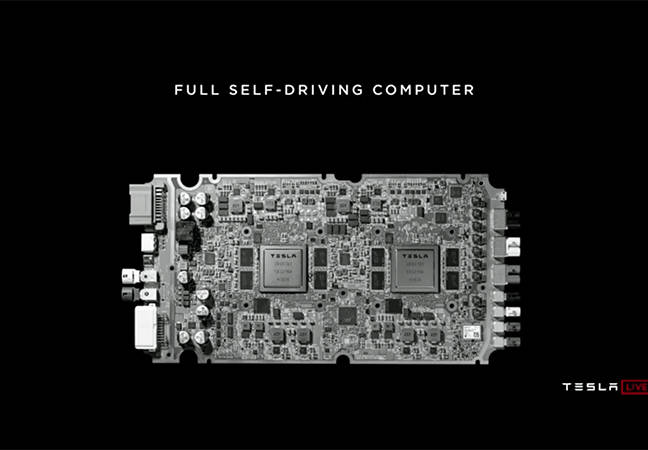This article is more than 1 year old
Tesla touts totally safe, not at all worrying self-driving cars – this time using custom chips
Good bye to Nvidia, hello to the Samsung-fabbed FSD
Tesla claims to have built a "fully self driving" (FSD) system using custom-designed math processors, allowing its vehicles to potentially drive themselves completely autonomously.
At an all-day event at the company's Los Angeles headquarters on Monday, executives were on stage to outline the computer system, which has been installed in new Tesla cars since around last month and can be retrofitted into older models for a $7,000 fee.
Tesla previously used Nvidia's Drive hardware to power its cars' almost-self-driving Autopilot feature, so, from what we can tell, Tesla effectively today bragged its vehicles are now shipping with its own self-driving math chips, rather than Nvidia's, and these can be retro-fitted if you already have a Tesla.

Remember that $5,000 you spent on Tesla's Autopilot and then sued when it didn't deliver? We have good news...
READ MOREThis homegrown FSD technology is supposed to eventually turn the upmarket cars into "fully" self-driving rides that can operate without a human at the wheel, though whether it can actually achieve that now or in the immediate future that remains to be seen. Tesla has been promising this kind of tech for years, and not quite making the grade.
Right now, Tesla's Autopilot feature is a level-two autonomous car system, meaning it's a driver assistance tool. The aim is to push firmware updates over the air to vehicles to bring their software up to level four, which is what you'd call baseline human-free driving, all powered by the supposedly superior FSD hardware.
At the center of this plan are 14nm FinFET number-crunching chips that Tesla itself designed, and which its lead silicon engineer claimed is capable of handling and interpreting the vast quantities of data that are produced in real time from a car's eight cameras, 12 ultrasonic sensors, and front-facing radar.
These Samsung-fabricated neural network accelerators, Tesla claims, enable the system to analyze 2,100 video frames per second, and make driving decisions based on this flow of information. The head of Tesla's Autopilot program, Pete Bannon, gave a lengthy technical description of the chip while Tesla CEO Elon Musk jumped in to offer a combination of simple explanations and hype.
Bannon is a legend in the semiconductor world, by the way: he worked on the Alpha architecture, ended up at Intel and then PA Semi, which was bought by Apple to work on its line of homegrown Arm-based processors for iPhones and iThings. Bannon joined Tesla from Apple in 2016.
The AEC-Q100 qualified FSD hardware, meanwhile, uses the "best chip in the world… by a huge margin," according to Musk. He was also at pains to say that safety is at the center of the design, and that the company's engineers had been "conservative" though in future they would allow the code to "be more aggressive." Musk also said Tesla was working on the FSD's successor, which would be – of course – "three times better."
Thanks to a number of high-profile Tesla crashes when drivers were using its super-cruise-control Autopilot feature, there is a lot of skepticism about the company's "fully" self-driving claims, especially given the fact the car biz is underperforming financially and is due to announce its latest figures this week.
If the invited journalists were suspicious of Musk's claim that a company that has never produced a microchip of its own before had produced the "best chip in the world" in less than three years, starting mid-2016, they didn't it let be known. Instead, a livestream of the event saw questioners praise Musk and Tesla for the achievements that had been outlined to them just moments before.
Figure fiddling
Online observers were less enamored. For example, one semiconductor expert noted that Tesla was twisting figures to make its system look better than its previous Nvidia-built electronics. In one slide, Tesla claimed its dual-processor 72W FSD system could do up to 144 trillion math calculations per second whereas Nvidia's AI-focused Xavier GPU could only do 21 trillion – making Musk's silicon roughly seven times better.

Here it is: the best chip in the world. Apparently
"Comparison is deceptive," warned Mike Demler, senior analyst at The Linley Group, on the 144 versus 21 figures. "Tesla has a two-chip system at 72W. Footnote compares to just one Xavier using 50 per cent of GPU." A truer comparison would be Tesla's chip getting a 2.4x computational improvement for a 1.2x increase in power, he noted. Nvidia also described Tesla's comparison as "inaccurate."
The current-generation FSD chipset has two fully independent math processors on board, and each processor houses two 15W neural accelerators that can each perform up to 36 trillion operations per second at 2GHz, adding up to 144 trillion per second for the full dual-processor system. Each of these processors receive full video from the car and make their own independent evaluations before another part of the system compares them to make sure they match.
Each 260mm2 processor chip die apparently sports 250 million gates and six billion transistors, and can access LPDDR4 RAM at up to 4,266Gb/s using 128-bit wide-accesses with a peak memory bandwidth of 68GB/s. Each chip die contains a GPU running at 1GHz that can hit up to 600 GFLOPS using FP32 and FP16 math, we're told, as well as 12 Arm Cortex-A72 CPU cores running at 2.2GHz to direct them.
There are also two power supplies, with one powering one half of the car's sensors and the other maintaining the other half. "Any part of this could fail and the car will keep driving," Musk added. "The probability of this computer failing is substantially lower than someone losing consciousness." Although he also confessed that there was a "slight chance of a fender bender," with the system.
Tesla has been repeatedly criticized, including by the autonomous car industry, for making claims that don't match with reality. It sells a "full self-driving" add-on but it has significant limitations and still requires human intervention.
The system can currently direct a car on a freeway and autopark but pretty much everything else requires a driver to physically intervene. The new system should recognize things like traffic lights and stop signs, meaning that it could start navigating city traffic.
Perhaps most importantly, Tesla says that its cars will now contain everything they need to do full autonomous driving, and that it will slowly get there through software updates. In other words, with the sensors and FSD chipset in place, the rest will slowly come via over-the-air firmware upgrades, allegedly.
Lidar
Musk was notably dismissive of lidar – which many self-driving car manufacturers use to give the car a 3D view of what is happening around it. When an Uber self-driving car struck and killed a pedestrian in Arizona in March 2018, some pointed to the lack of lidar as being a major contributor.
But Musk called lidar "doomed," "lame," and "a fool's errand," and confidently predicted that all self-driving companies would in future "dump lidar… because in cars it's frigging stupid, expensive and unnecessary." Tesla has a forward-facing radar system that does not use visible spectrum and enables to the car to "see through fog or dust", Musk noted.
Google's Waymo also agrees that lidar isn't needed, though another major company, Aeye assured us last month that it was just as confident that self-driving cars would soon see the necessity of having lidar. Earlier this month, researchers outlined how a Tesla could be made to veer off course into oncoming traffic with a few simple stickers on the ground, demonstrating the danger of relying too heavily on video camera inputs.
Of course such a system, even if it can theoretically analyze images fast enough and react in a sufficiently short period of time is still entirely dependent on the machine-learning software under the hood.
And on that Tesla admitted – as every tech company is forced to admit every time AI is presented as the answer to a problem – that it still has to sufficiently "train" its neural networks in order to stop its cars from killing people.
"There is no substitute for real data," explained Tesla's senior director of artificial intelligence, Andrej Karpathy. The company is building up that data from its cars already on the road, by gathering up and analyzing their video footage, and that its training data will only get better over time as more drivers cover more roads. It is a familiar refrain for tech company that echoes Facebook's explanation for why it wasn't able to stop the livestreaming and subsequent reposting of a live murder video in New Zealand earlier this year.
Tired of the hype
This being a Tesla event featuring Elon Musk, the company also made a number of confident big claims that are unlikely to happen either in the promised timeline, if at all.
Musk said he was "very confident" that the company will be able to launch a "robot taxi" program next year where people's Teslas will drive around automatically picking people up and dropping them off, for which the car owners will be allowed to keep 70 to 75 per cent of the revenue. These vehicles will be level five, or fully autonomous, it is claimed. A million or more self-driving Teslas on public streets, Musk said.
Despite all the bold claims – to have already created a new super-chip that puts it ahead of the self-driving market to creating a fleet of robot taxis in 2020 – the markets were notably less excitable than the journos in the room. The automaker's share price has flittered up and down inconclusively all day.
It is right now down 3.85 per cent, not bad for a event dubbed Autonomy Day for, er, investors. Tesla, by the way, got a judge on Friday to issue a temporary restraining order against a short seller, requiring him to stay away from its factory and employees. ®
